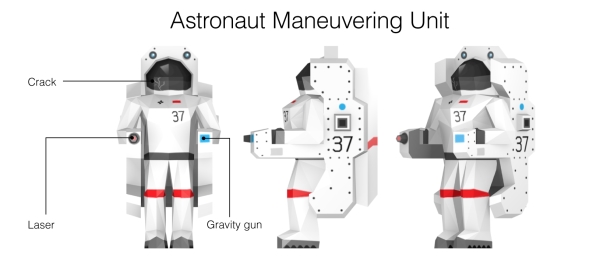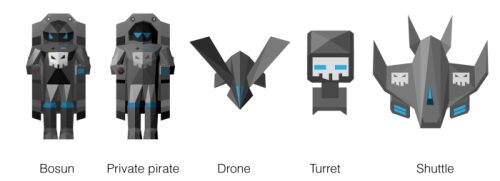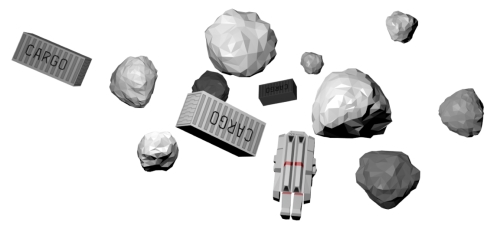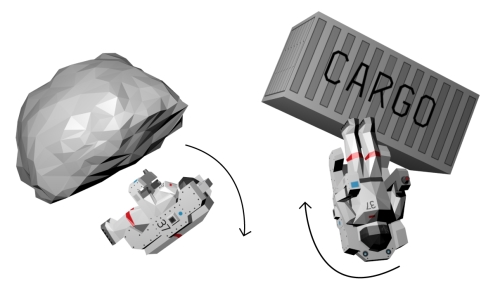Of course, the primal intention of many fresh game developers is to create a first-person shooter. This is a good dream, but a very bad idea. A competitive modern FPS, even if it is going to be developed for handheld devices, requires titanic efforts, that is, a gigantic job that will be enormous for small teams. There should be an original concept that can attract the attention of the audience: a good story, tons of accurate 3D models and textures, great animation, perfect special effects, optimized graphics, minimum glitches, and an ideal balance in a new, competitive FPS. Don't forget the hundreds of hidden nuances and pitfalls.
It is more reasonable to reduce our ambitions a little bit and start with a smaller project to experiment with. It is good to take some ideas from the good old arcades. For example, the Shoot 'em up subgenre, where a character is surrounded with lots of enemies and needs to hold fire all the time, is the mechanics from Space Invaders. The animation of a 3D character is not an easy job. For your first game, you may try to make the process easier by reducing a number of movable parts of the protagonist. The most obvious way is to put him inside a vehicle; in that case, there will be no need to create any types of walking cycle animations. For instance, the protagonist may move using some sort of flying vehicle. As far as the Space Invaders are concerned, it is good to put the player into space. Thus, the main character will be an astronaut, and use a small space craft to move. He will have a laser gun. There will be some asteroids and space junk around as well as angry enemies. The protagonist is alone, so the objective is clear—to return to the other people who are battling their way through hordes of opponents. Yes, we got the idea!
A huge starship called Danube is moving in space. This is a cargo ship carrying unique resources from colonies on far away planets. It comes back fully loaded to Earth. The mission is very important because Earth is totally out of resources, and completely depends on regular transports from the new lands (the far away planets are still in the state of terraformation, so they are not ready for the normal life of human beings). If the ship will not return in time or lose its precious cargo, mankind will face hard times. The world economics will collapse, there will be a huge political crisis, and there might even be several wars for dribs and drabs of resources that are conserved by some countries. Therefore, all of the crew fully concentrate on their extremely important objective. The ship must be in perfect order; each system should work like clockwork. Since everyday an army of engineers exits into open space for maintenance, they are using special space suits with small engines to fly over the ship. From some distance, it may look like a hive surrounded with bees.

The protagonist is one such bee. He needs to check the communication module situated at the starboard. Now, the ship is in a dangerous environment. There are lots of asteroids and meteors around the ship. Each of them can easily detect important nodes and components. Besides, there are many artificial objects such as old satellites, fragments of ships crushed against minor planets, and cargo containers. The engineers have a double shift. This is a dark territory; space pilots do not like this part of the journey because the space junk is an ideal way for space pirates to create an ambush.
Suddenly, the Danube is assaulted. Dozens of small ships painted in dark colors start a firefight. The communication module is hit; it explodes massively, and a big fragment of the casing hits the protagonist directly on the helmet. The astronaut is thrown away from the ship. He crashes his back into a rock; a new explosion pushes him away. He is senseless because of the impact, being unable to control his suit in space.
Moreover, many systems are now broken. The head-up-display (HUD) alerted that the suit is completely out of order. Only the support system is still working normally, and the level of oxygen is satisfactory. The blast wave carries the protagonist away from the ship. He moves farther away every second; the stars mirrored in the helmet's glass disappear. Soon the astronaut will be gone, and this is the code name of the game: Astronaut is Gone.
Soon the protagonist will wake up; he will be okay, only having a very bad headache. He will be totally alone, and there will be no Danube on the horizon. His main objective will be returning to the ship. The communication module has gone; so, he will have no opportunity to communicate with the bridge. His only chance will be to find a signal from one of the space lighthouses that can transfer the intermediate coordinates of the ship. The astronaut will catch such a signal and begin his journey to the lighthouse; he will not know what he will meet ahead.
There can be two main gaming modes in the game named Astronaut is Gone. They are as follows:
- Story: All levels are created according to the plot. They have a fixed structure, design, length, and number of enemies. Each level finishes at a lighthouse. The last level includes an image of the Danube since the protagonist will engage in combat with pirates who have occupied his ship. By defeating them all, the player finishes the game.
- Arcade: The game universe is generated randomly based on various templates. Obstacles and enemies appear constantly; their speed and power increases with time. The objective is to stay alive for as long as possible; each second counts. This mode can use the principles of rail shooters. There is no puzzle.
The main hero of the Astronaut is Gone game is silent and mysterious. We know very little about him, his past, and habits; even his name is unknown. The character is referred to simply as the astronaut. All his individuality is hidden under the shell of the space suit. He is a valuable introvert. He can be considered an ideal game avatar, a blank paper that the player may fill with his own personality.
Thus, most of our attention is paid to the exterior of the protagonist. He is not only wearing an ordinary space suit, but is also using a mini space vehicle, the Astronaut Maneuvering Unit (AMU), which is also known as the Astronaut Propulsion Unit.

If you have seen any images of astronauts working outside of a space station, you should be familiar with such types of apparatuses. It looks like a very massive knapsack with some maneuvering engines and life support systems. Astronauts control them using joysticks and buttons placed on special racks.
In the game, the AMU is a little more futuristic. It features faster engines, a special visual system based on advanced artificial intelligence (known as HUD), various useful support systems, and of course, it carries some tools that can be used as weapons as well. The protagonist is one of the starship engineers. He works in the 13th crew, and his identification number is 37.
After the attack, the 37th Unit is a little bit damaged. All internal systems will be in order soon after the automatic maintenance, but one detail will be kept unchanged: a heavy fragment has hit the space helmet; so, a crack has appeared in the glass. It is not strictly dangerous, but gives some sense of suspense by illustrating the fact that the astronaut is fragile, and he is protected only by a thin shell that can be easily destroyed. This is also a way to add some individuality to the Unit. The cracks make it special. Another advantage is a break of symmetry. A character that consists of two identical parts is always perceived to be a little bit unnatural and boring (unless it is a ceramic vase). Always try to think of such fragments of the design. Tiny details may turn the visual look into a little story. They can even be the integral part of the plot that are being used in some future twists, for example, Elizabeth's little finger covered by a thimble in a gorgeous game Bioshock Infinite from Irrational Games.
This unusual detail is perceived by a player all over the game looking like an original fashion accessory, but then the true meaning is exposed very dramatically. A tiny design idea produces a very powerful story effect.
The Unit may move in many directions. It has several maneuvering engines; so, it is quite a brisk machine. The only point is a little inertia. It cannot change the vector of movement at once; so, there is always a little delay in turns; the fly is always smooth without broken trajectories. Such specialty makes the behavior more naturalistic, and adds some reasonable difficulty to the game. The player has to calculate some actions in advance. For instance, the player has no opportunity to stop the Unit dead. Still, there is no friction in space, and he needs to turn on the reverse engines to compensate the motion.
Obviously, the main antagonists are the angry pirates who have attacked the Danube earlier. They are scattered all over space, and are hiding behind the rocks. All of them are humans, not aliens; so, they use technologies from Earth. In most cases, that refers to the different space vehicles stolen from other ships. For example, the pirates utilize AMUs to move. They are painted in dark gray to be more inconspicuous. Here's the list of all the variations of enemies:

- Private pirate: This is the simplest type of pirate. It is a direct copy of the protagonist. The pirate utilizes the same AMU as the main hero; thus, the pirate has no armor, and only has one laser gun.
- Bosun: This is a pirate with a heavily modified and armored Unit. It has two lasers that are operating simultaneously. This is a hard enemy. His only weak point is a slower speed of maneuvering.
- Drone: This is a small unmanned space vehicle carrying a laser gun. The machine and maneuver ability are very fast; nevertheless, it can be destroyed by a single hit. The main point to be noted is their number. Drones usually try to attack in a swarm.
- Turret: This is an automated gun that is fixed on a rock or on another type of big obstacle. The simplest version has only one laser gun that is oriented forward. More advanced models have many barrels that are turned in various directions.
- Pirate shuttle: This is the most powerful enemy in the game, for example, it may guard the lighthouse at the end. It looks like a small spaceship with several heavy guns. It requires a lot of effort to be defeated.
The astronaut's journey to the lighthouse is not a walk in the park; it is full of different dangerous situations and hindrances. This is deep space. First of all, there are lots of objects floating around that the player should try to dodge; otherwise, he will lose some portions of his health after contact with them. It is much harder if the AMU is moving fast. Like in arcade flying simulators, the player maneuvers in space, trying to squeeze between the rocks and other types of space junk. The obstacles can be of very complex shapes, and rotate chaotically in space; so, it is a task to avoid contact with their fragments.

The space junk consists of objects of different size and mass. They are as follows:
- Massive: These are various big rocks, cargo containers, and large fragments of crushed spaceships
- Medium: These are old satellites, medium containers, crates, meteors, and small fragments of casing
- Small: These are little fragments of exploded rocks, tiny particles of star dust, and so on
The rocks are mostly awry spheres or ellipsoid with some craters on the surface. They may also feature some peaks. Rare examples (really large ones) may have large perforating tunnels; so, the player can try to fly through them. Generally, the players know their own speed being fixed in space, but most of them can rotate around an incidental axis. Containers as well as fragments of ships have the same behavior. They are passive elements. They cannot attack the protagonist, follow him, or intentionally change their position to collide with the Unit. The trickiest types of obstacles are space flotsam and jetsam. Contrary to rocks and containers, they can have very complex and bizarre geometry. Various traps can be made of them. By rotating at unexpected angles, broken metallic trusses can be a captious barrier for the player to pass through. A series of trusses rotating in opposite directions may create a corridor of pendulums, a level design cliché, where the player needs to react fast. The player has to pass various dangerous barriers such as sharp metallic blades, heavy pendulums, and laser beams that are constantly moving. To force the player to move into such a hazardous territory, other elements such as clusters of rocks and anomalies can be used. They will block all ways except for the dangerous corridor.
There is also a stream of objects in the game. There is an endless flow of different small obstacles at some levels. They can have different speed, density, and depth (in most cases, they are pretty flat, only one row of elements). This is a non-trivial barrier, requiring good pilot skills or active usage of the laser gun.
Another dynamic and inanimate enemy is a comet. This is a massive body that moves much faster than other obstacles, and it has a long tail. If the player collides with the protagonist, it pushes him hard backwards, and takes a larger portion of his health. Therefore, the player should avoid such a collision at any cost. Optionally, the comet's tail may have some effects on the Unit, either negative or positive.
It might sound amusing, but collisions are a very important part of the game because they demonstrate the advantages of the 3D engine. Being crashed into an edge of a massive obstacle, the protagonist begins to rotate in space at different angles. For a few moments, the AMU becomes uncontrollable. A special alert appears signaling that space orientation is lost. Virtual control turns into disable state, but a special large button called Align is displayed. The player should click on it quickly to get the control back. This is not an easy task, especially if the Unit, being in an improvised spin, has touched other objects. In a bad scenario, there can be a chain of collisions, causing a pretty long and spectacular tumbling of the character.
To add some humor to the situation, the game may utilize a special soundtrack for such moments. Some allusions on The Blue Danube by Johann Strauss recall the famous film by Stanley Kubrick, 2001, A Space Odyssey (1968), ornamenting with that beautiful piece of music. While rotating, the astronaut dances a waltz. The character can also complain aloud about the situation making some funny commentaries or noises.

By colliding into a central part of a massive obstacle, the Unit simply stops. For a few moments, the protagonist is stunned, and the virtual controls do not function. If the obstacle has its own speed, it begins to push the Unit like a bulldozer, carrying it backward. The player should unstick from the surface of the object and fly over it.
Medium objects such as satellites do not cause the protagonist to tumble, but shift his trajectory a little bit, change his speed dramatically, and fly off sideways. Tiny particles have no effect on the Unit as they are too small to have enough energy; they only bounce from the surface of the astronaut. It may look very beautiful, alluding to the scenes from the science fiction film Event Horizon (1997), where a character in a space suit was surrounded with hundreds of fragments of an exploded spaceship.
